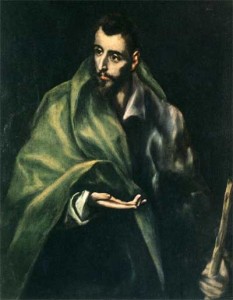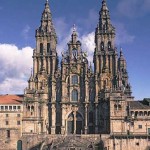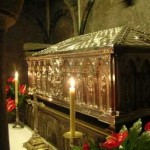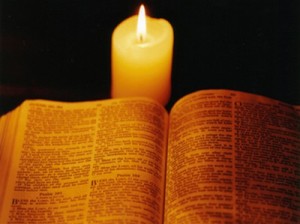 Dr Matthew Bunson co-wrote, with Margaret Bunson, a compelling biography of St. Damien. Â
Dr Matthew Bunson co-wrote, with Margaret Bunson, a compelling biography of St. Damien. Â
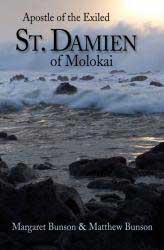 Dr. Bunson took time to share many more aspects of the life of this incredible saint.
Dr. Bunson took time to share many more aspects of the life of this incredible saint.
[powerpress]
St Jozef Damien De Veuster (1840-1889) – from vatican.va
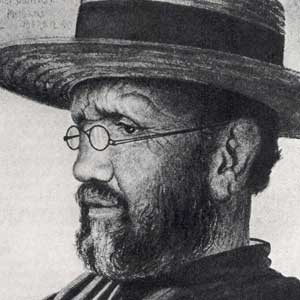 St Jozef Damien De Veuster, ss.cc, was born at Tremelo, Belgium, on 3 January 1840 (see also p. 8). Jozef (“Jef”) began his novitiate with the Congregation of the Sacred Hearts of Jesus and Mary (“Picpus Fathers”) at the beginning of 1859 and took the name Damien. He would pray every day before a picture of St Francis
St Jozef Damien De Veuster, ss.cc, was born at Tremelo, Belgium, on 3 January 1840 (see also p. 8). Jozef (“Jef”) began his novitiate with the Congregation of the Sacred Hearts of Jesus and Mary (“Picpus Fathers”) at the beginning of 1859 and took the name Damien. He would pray every day before a picture of St Francis
Xavier, patron of missionaries, to be sent on a mission. In 1863 his brother, who was to leave for a mission in the Hawaiian Islands, fell ill. Since preparations for the voyage had already been made, Damien obtained permission from the Superior General to take his brother’s place. He landed in Honolulu on 19 March 1864. He was ordained to the priesthood on the following 21 May.
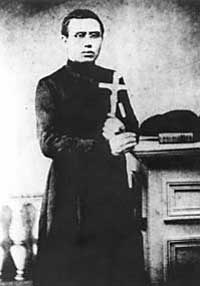 At that time, the Hawaiian Government decided on the harsh measure of quarantine aimed at preventing the spread of leprosy: the deportation to the neighbouring Island of Molokai of all those infected by what was then thought to be an incurable disease. The entire mission was concerned about the abandoned lepers and Bishop Louis Maigret, a Picpus father, felt sure they needed priests. He did not want to send anyone “in the name of obedience” because he was aware such an assignment was a potential death sentence. Of the four brothers who volunteered, Damien was the first to leave on 10 May 1873 for Kalaupapa.
At that time, the Hawaiian Government decided on the harsh measure of quarantine aimed at preventing the spread of leprosy: the deportation to the neighbouring Island of Molokai of all those infected by what was then thought to be an incurable disease. The entire mission was concerned about the abandoned lepers and Bishop Louis Maigret, a Picpus father, felt sure they needed priests. He did not want to send anyone “in the name of obedience” because he was aware such an assignment was a potential death sentence. Of the four brothers who volunteered, Damien was the first to leave on 10 May 1873 for Kalaupapa.
At his own request and that of the lepers, he remained on Molokai. Having contracted leprosy himself, he died on 15 April 1889, at the age of 49, after serving 16 years among the lepers. He was buried in the local cemetery under the same Pandanus tree where he had first slept upon his arrival in Molokai. His remains were exhumed in 1936 at the request of the Belgian Government and translated to a crypt of the Church of the Congregation of the Sacred Hearts at Louvain. Damien is universally known for having freely shared the life of the lepers in quarantine on the Kalaupapa Peninsula of Molokai. His departure for the “cursed isle”, the announcement of his illness (leprosy) in 1884 and his subsequent death deeply impressed his contemporaries of all denominations.
Damien was above all a Catholic missionary. Fr Damien is known today as a hero of charity because he identified so closely with 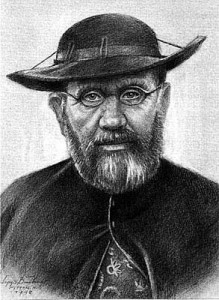 thevictims of leprosy.
thevictims of leprosy.
He respected the religious convictions of others; he accepted them as people and received with joy their collaboration and their help. With a heart wide open to the most abject and wretched, he showed no difference in his approach and in his care of the lepers. In his parish ministry or in his works of charity he found a place for everyone.
He continues to inspire thousands of believers and non-believers who wish to imitate him and to discover the source of his heroism. People of all creeds and all philosophical systems recognized in him the Servant of God which he always revealed himself to be, and respect his passion for the salvation of souls.
Pope John Paul II beatified Damien de Veuster in Brussels on 4 June 1995.
Tags: apostle, damien de veuster, Dr Matthew Bunson, lepers, Margaret Bunson, matthew bunson
This entry was posted on Friday, May 10th, 2013 at 5:37 am
You can follow any responses to this entry through the RSS 2.0 feed.
BENEDICT XVI
GENERAL AUDIENCE
Wednesday, 21 June 2006
James, the Greater
We are continuing the series of portraits of the Apostles chosen directly by Jesus during his earthly life. We have spoken of St Peter and of his brother, Andrew. Today we meet the figure of James. The biblical lists of the Twelve mention two people with this name: James, son of Zebedee, and James, son of Alphaeus (cf. Mk 3: 17,18; Mt 10: 2-3), who are commonly distinguished with the nicknames “James the Greater” and “James the Lesser”.
These titles are certainly not intended to measure their holiness, but simply to state the different importance they receive in the writings of the New Testament and, in particular, in the setting of Jesus’ earthly life. Today we will focus our attention on the first of these two figures with the same name.
The name “James” is the translation of Iakobos, the Graecised form of the name of the famous Patriarch, Jacob. The Apostle of this name was the brother of John and in the above-mentioned lists, comes second, immediately after Peter, as occurs in Mark (3: 17); or in the third place, after Peter and Andrew as in the Gospels of Matthew (10: 2) and Luke (6: 14), while in the Acts he comes after Peter and John (1: 13). This James belongs, together with Peter and John, to the group of the three privileged disciples whom Jesus admitted to important moments in his life.
Since it is very hot today, I want to be brief and to mention here only two of these occasions. James was able to take part, together with Peter and John, in Jesus’ Agony in the Garden of Gethsemane and in the event of Jesus’ Transfiguration. Thus, it is a question of situations very different from each other: in one case, James, together with the other two Apostles, experiences the Lord’s glory and sees him talking to Moses and Elijah, he sees the divine splendour shining out in Jesus.
On the other occasion, he finds himself face to face with suffering and humiliation, he sees with his own eyes how the Son of God humbles himself, making himself obedient unto death. The latter experience was certainly an opportunity for him to grow in faith, to adjust the unilateral, triumphalist interpretation of the former experience: he had to discern that the Messiah, whom the Jewish people were awaiting as a victor, was in fact not only surrounded by honour and glory, but also by suffering and weakness. Christ’s glory was fulfilled precisely on the Cross, in his sharing in our sufferings.
This growth in faith was brought to completion by the Holy Spirit at Pentecost, so that James, when the moment of supreme witness came, would not draw back. Early in the first century, in the 40s, King Herod Agrippa, the grandson of Herod the Great, as Luke tells us, “laid violent hands upon some who belonged to the Church. He had James, the brother of John, killed by the sword” (Acts 12: 1-2).
The brevity of the news, devoid of any narrative detail, reveals on the one hand how normal it was for Christians to witness to the Lord with their own lives, and on the other, that James had a position of relevance in the Church of Jerusalem, partly because of the role he played during Jesus’ earthly existence.
A later tradition, dating back at least to Isidore of Seville, speaks of a visit he made
to Spain to evangelize that important region of the Roman Empire. According to another tradition, it was his body instead that had been taken to Spain, to the city of Santiago de Compostela. As we all know, that place became the object of great veneration and is still the destination of numerous pilgrimages, not only from Europe but from the whole world. This explains the iconographical representation of St James with the pilgrim’s staff and the scroll of the Gospel in hand, typical features of the travelling Apostle dedicated to the proclamation of the “Good News” and characteristics of the pilgrimage of Christian life.
Consequently, we can learn much from St James: promptness in accepting the Lord’s call even when he asks us to leave the “boat” of our human securities, enthusiasm in following him on the paths that he indicates to us over and above any deceptive presumption of our own, readiness to witness to him with courage, if necessary to the point of making the supreme sacrifice of life.
Thus James the Greater stands before us as an eloquent example of generous adherence to Christ. He, who initially had requested, through his mother, to be seated with his brother next to the Master in his Kingdom, was precisely the first to drink the chalice of the passion and to share martyrdom with the Apostles.
And, in the end, summarizing everything, we can say that the journey, not only exterior but above all interior, from the mount of the Transfiguration to the mount of the Agony, symbolizes the entire pilgrimage of Christian life, among the persecutions of the world and the consolations of God, as the Second Vatican Council says. In following Jesus, like St James, we know that even in difficulties we are on the right path.
Tags: apostle, martyr, pilgrimage, pope benedict xvi
This entry was posted on Wednesday, July 25th, 2012 at 8:49 am
You can follow any responses to this entry through the RSS 2.0 feed.
“Follow me, and I will make you fishers of men”
What is God’s call on your life and are you ready to respond? When Jesus began his ministry he went every where he could – the streets, towns, hills and lakeside of Galillee – to speak to people about the kingdom of God. He chose as his closest friends and coworkers those who were ready to follow as his disciples and he gave them an unusual mission – “to catch people for the kingdom of God”. What kind of disciples did Jesus choose? Smelly fishermen! In the choice of the first apostles we see a characteristic feature of Jesus’ work: he chose very ordinary people. They wer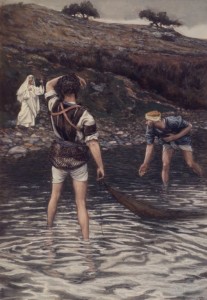 e non-professionals, had no wealth or position of power or fame in society. They were chosen from the common people who did ordinary things, had no special marks of education, and no social advantages. Jesus wanted ordinary people who could take an assignment and do it extraordinarily well. He chose these individuals, not for what they were, but for what they would be capable of becoming under his direction and power. When the Lord calls us to be his disciples, we must not think we have nothing to offer him in exchange. The Lord takes what ordinary people, like us, can offer and uses it for greatness in his kingdom. Do you believe that God wants to work through and in you for his glory?
e non-professionals, had no wealth or position of power or fame in society. They were chosen from the common people who did ordinary things, had no special marks of education, and no social advantages. Jesus wanted ordinary people who could take an assignment and do it extraordinarily well. He chose these individuals, not for what they were, but for what they would be capable of becoming under his direction and power. When the Lord calls us to be his disciples, we must not think we have nothing to offer him in exchange. The Lord takes what ordinary people, like us, can offer and uses it for greatness in his kingdom. Do you believe that God wants to work through and in you for his glory?
“Lord Jesus, you have called me personally by name, just as you called your first disciples, Simon, Andrew, and James. Fill me with the joy of your gospel and help me to be a good and faithful witness of your kingdom to all I meet.”
for the full reflection visit : Daily Reading and Meditation
Tags: apostle, catholic, catholic podcast, catholic prayer, cathollc spirituality, disciples, fishers of men, scripture reflection, st andrew the apostle
This entry was posted on Wednesday, November 30th, 2011 at 12:01 am
You can follow any responses to this entry through the RSS 2.0 feed.
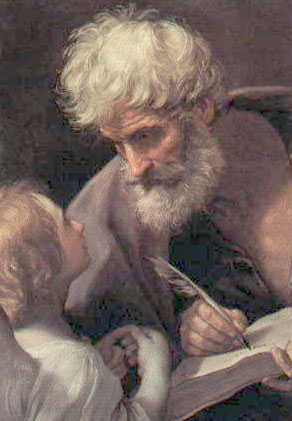 St. Matthew, one of the twelve Apostles, is the author of the first Gospel.Son of Alphaeus, he lived at Capenaum on Lake Genesareth. He was a Roman tax collector, a position equated with collaboration with the enemy by those from whom he collected taxes. Jesus’ contemporaries were surprised to see the Christ with a traitor, but Jesus explained that he had come “not to call the just, but sinners.†Matthew’s Gospel is given pride of place in the canon of the New Testament, and was written to convince Jewish readers that their anticipated Messiah had come in the person of Jesus. He preached among the Jews for 15 years; his audiences may have included the Jewish enclave in Ethiopia, and places in the East.
St. Matthew, one of the twelve Apostles, is the author of the first Gospel.Son of Alphaeus, he lived at Capenaum on Lake Genesareth. He was a Roman tax collector, a position equated with collaboration with the enemy by those from whom he collected taxes. Jesus’ contemporaries were surprised to see the Christ with a traitor, but Jesus explained that he had come “not to call the just, but sinners.†Matthew’s Gospel is given pride of place in the canon of the New Testament, and was written to convince Jewish readers that their anticipated Messiah had come in the person of Jesus. He preached among the Jews for 15 years; his audiences may have included the Jewish enclave in Ethiopia, and places in the East.
 Listen to none other than Mark Hart the Bible Geek about the great work of St. Matthew…of course, the Gospel according to St. Matthew[powerpress]
Listen to none other than Mark Hart the Bible Geek about the great work of St. Matthew…of course, the Gospel according to St. Matthew[powerpress]
Personal note, my favorite Matthew passage (from Chapter 25): “When the Son of Man comes in his glory, and all the angels with him, he will sit upon his glorious throne, and all the nations will be assembled before him. And he will separate them one from another, as a shepherd separates the sheep from the goats. He will place the sheep on his right and the goats on his left. Then the king will say to those on his right, ‘Come, you who are blessed by my Father. Inherit the kingdom prepared for you from the foundation of the world. For I was hungry and you gave me food, I was thirsty and you gave me drink, a stranger and you welcomed me, naked and you clothed me, ill and you cared for me, in prison and you visited me.‘ Then the righteous will answer him and say, ‘Lord, when did we see you hungry and feed you, or thirsty and give you drink? When did we see you a stranger and welcome you, or naked and clothe you? When did we see you ill or in prison, and visit you?’ And the king will say to them in reply, ‘Amen, I say to you, whatever you did for one of these least brothers of mine, you did for me.’ Then he will say to those on his left, ‘Depart from me, you accursed, into the eternal fire prepared for the devil and his angels. For I was hungry and you gave me no food, I was thirsty and you gave me no drink, a stranger and you gave me no welcome, naked and you gave me no clothing, ill and in prison, and you did not care for me.’ Then they will answer and say, ‘Lord, when did we see you hungry or thirsty or a stranger or naked or ill or in prison, and not minister to your needs?’ He will answer them, ‘Amen, I say to you, what you did not do for one of these least ones, you did not do for me.’ And these will go off to eternal punishment, but the righteous to eternal life.”
Tags: apostle, catholic, catholic podcast, catholic prayer, cathollc spirituality, gospel of matthew, levi, martyr, st matthew, tax collectors
This entry was posted on Wednesday, September 21st, 2011 at 12:23 am
You can follow any responses to this entry through the RSS 2.0 feed.

